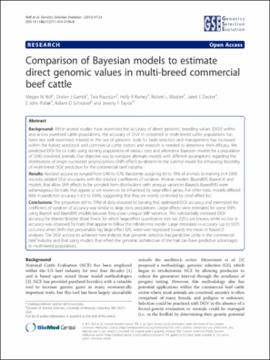| dc.contributor.author | Rolf, Megan M. | |
| dc.contributor.author | Garrick, Dorian J. | |
| dc.contributor.author | Fountain, Tara | |
| dc.contributor.author | Ramey, Holly R. | |
| dc.contributor.author | Weaber, Robert L. | |
| dc.contributor.author | Decker, Jared E. | |
| dc.contributor.author | Pollak, E. John | |
| dc.contributor.author | Schnabel, Robert D. | |
| dc.contributor.author | Taylor, Jeremy F. | |
| dc.date.accessioned | 2019-09-25T18:24:41Z | |
| dc.date.available | 2019-09-25T18:24:41Z | |
| dc.date.issued | 2015-04-01 | |
| dc.identifier | oksd_rolf_comparisonofbay_2015 | |
| dc.identifier.citation | Rolf, M. M., Garrick, D. J., Fountain, T., Ramey, H. R., Weaber, R. L., Decker, J. E., ... Taylor, J. F. (2015). Comparison of Bayesian models to estimate direct genomic values in multi-breed commercial beef cattle. Genetics Selection Evolution, 47, Article 23. https://doi.org/10.1186/s12711-015-0106-8 | |
| dc.identifier.uri | https://hdl.handle.net/11244/321434 | |
| dc.description.abstract | Background: While several studies have examined the accuracy of direct genomic breeding values (DGV) within and across purebred cattle populations, the accuracy of DGV in crossbred or multi-breed cattle populations has been less well examined. Interest in the use of genomic tools for both selection and management has increased within the hybrid seedstock and commercial cattle sectors and research is needed to determine their efficacy. We predicted DGV for six traits using training populations of various sizes and alternative Bayesian models for a population of 3240 crossbred animals. Our objective was to compare alternate models with different assumptions regarding the distributions of single nucleotide polymorphism (SNP) effects to determine the optimal model for enhancing feasibility of multi-breed DGV prediction for the commercial beef industry. | |
| dc.description.abstract | Results: Realized accuracies ranged from 0.40 to 0.78. Randomly assigning 60 to 70% of animals to training (n is about 2000 records) yielded DGV accuracies with the smallest coefficients of variation. Mixture models (BayesB95, BayesC[pi]) and models that allow SNP effects to be sampled from distributions with unequal variances (BayesA, BayesB95) were advantageous for traits that appear or are known to be influenced by large-effect genes. For other traits, models differed little in prediction accuracy (~0.3 to 0.6%), suggesting that they are mainly controlled by small-effect loci. | |
| dc.description.abstract | Conclusions: The proportion (60 to 70%) of data allocated to training that optimized DGV accuracy and minimized the coefficient of variation of accuracy was similar to large dairy populations. Larger effects were estimated for some SNPs using BayesA and BayesB95 models because they allow unequal SNP variances. This substantially increased DGV accuracy for Warner-Bratzler Shear Force, for which large-effect quantitative trait loci (QTL) are known, while no loss in accuracy was observed for traits that appear to follow the infinitesimal model. Large decreases in accuracy (up to 0.07) occurred when SNPs that presumably tag large-effect QTL were over-regressed towards the mean in BayesC0 analyses. The DGV accuracies achieved here indicate that genomic selection has predictive utility in the commercial beef industry and that using models that reflect the genomic architecture of the trait can have predictive advantages in multi-breed populations. | |
| dc.format | application/pdf | |
| dc.language | en_US | |
| dc.publisher | BioMed Central | |
| dc.rights | This material has been previously published. In the Oklahoma State University Library's institutional repository this version is made available through the open access principles and the terms of agreement/consent between the author(s) and the publisher. The permission policy on the use, reproduction or distribution of the material falls under fair use for educational, scholarship, and research purposes. Contact Digital Resources and Discovery Services at lib-dls@okstate.edu or 405-744-9161 for further information. | |
| dc.title | Comparison of Bayesian models to estimate direct genomic values in multi-breed commercial beef cattle | |
| osu.filename | oksd_rolf_comparisonofbay_2015.pdf | |
| dc.description.peerreview | Peer reviewed | |
| dc.identifier.doi | 10.1186/s12711-015-0106-8 | |
| dc.description.department | Animal Science | |
| dc.type.genre | Article | |
| dc.type.material | Text | |
| dc.subject.keywords | quantitative trait locus | |
| dc.subject.keywords | heritability estimate | |
| dc.subject.keywords | genomic selection | |
| dc.subject.keywords | quantitative trait locus effect | |
| dc.subject.keywords | carcass trait | |
